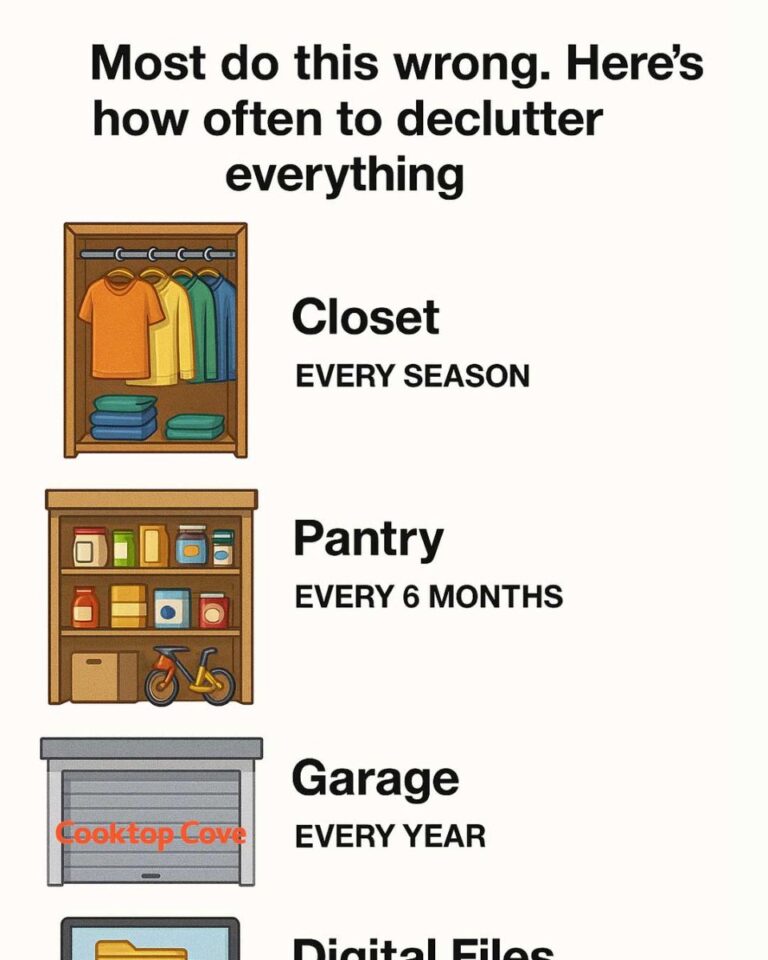3. How Often to Declutter Your Closet
Closets tend to get overcrowded. To keep them in order, declutter:
Twice a year, ideally at the change of seasons.
Steps:
Remove all clothing.
Sort into keep, donate, or discard.
Only keep what you truly wear or love.
4. Seasonal Closet Hacks for Easy Decluttering
Hanger Trick:
Start the season with hangers facing backward.
Turn them forward only after wearing.
At the season’s end, donate anything still facing backward.
Capsule Wardrobe:
Curate a seasonal wardrobe with versatile, mix-and-match pieces.
Reduces clutter and simplifies your wardrobe choices.
5. The Six-Month Pantry Purge
Every 6 months, do a pantry overhaul:
Remove all items.
Check expiration dates.
Discard expired or unwanted items.
Categorize remaining items (e.g., grains, canned goods).
Use labeled, clear storage containers for visibility and order.
6. Viral Pantry Organization Tips
Popular trends for pantry organization include:
Using uniform storage containers for dry goods.
Labeling with contents and expiration dates.
Installing tiered shelves or lazy Susans to use vertical space efficiently.
These methods make the pantry more functional and aesthetically pleasing.
7. Annual Garage Clean-Up
Your garage often turns into a clutter trap. Once a year:
Sort everything into keep, donate, and toss piles.
Be honest—if you haven’t used it in a year, let it go.
Install shelving or pegboards for tools.
Use labeled bins for seasonal items like decorations and gear.
8. Monthly Digital Decluttering
Decluttering isn’t just physical—digital clutter matters too. Once a month:
Unsubscribe from unwanted emails.
Delete unnecessary files and messages.
Organize files into folders.
Backup important data.
Remove unused apps from devices.
This keeps your digital life streamlined and stress-free.
9. The Psychological Benefits of Decluttering
Decluttering boosts mental health by:
Reducing anxiety and stress.
Improving focus and productivity.
Increasing happiness and satisfaction.
Creating a sense of control and accomplishment.
Living in a clutter-free space fosters a more positive, peaceful mindset.
10. How to Maintain a Clutter-Free Home
Keep your home decluttered with these habits:
Follow the “one in, one out” rule.
Tidy daily, especially before bed.
Assign every item a designated space.
Schedule regular decluttering based on room (closet bi-annually, pantry every 6 months, etc.).
These small habits add up to long-term success.
11. Common Decluttering Mistakes to Avoid
Avoid these pitfalls:
Taking on too much at once (leading to burnout).
Holding onto items due to guilt or “just in case.”
Buying organizers before decluttering—only buy what you truly need after the purge.
Tackle one space at a time and set realistic goals for each session.
3. How Often to Declutter Your Closet
Closets tend to get overcrowded. To keep them in order, declutter:
Twice a year, ideally at the change of seasons.
Steps:
Remove all clothing.
Sort into keep, donate, or discard.
Only keep what you truly wear or love.
4. Seasonal Closet Hacks for Easy Decluttering
Hanger Trick:
Start the season with hangers facing backward.
Turn them forward only after wearing.
At the season’s end, donate anything still facing backward.
Capsule Wardrobe:
Curate a seasonal wardrobe with versatile, mix-and-match pieces.
Reduces clutter and simplifies your wardrobe choices.
5. The Six-Month Pantry Purge
Every 6 months, do a pantry overhaul:
Remove all items.
Check expiration dates.
Discard expired or unwanted items.
Categorize remaining items (e.g., grains, canned goods).
Use labeled, clear storage containers for visibility and order.
6. Viral Pantry Organization Tips
Popular trends for pantry organization include:
Using uniform storage containers for dry goods.
Labeling with contents and expiration dates.
Installing tiered shelves or lazy Susans to use vertical space efficiently.
These methods make the pantry more functional and aesthetically pleasing.
7. Annual Garage Clean-Up
Your garage often turns into a clutter trap. Once a year:
Sort everything into keep, donate, and toss piles.
Be honest—if you haven’t used it in a year, let it go.
Install shelving or pegboards for tools.
Use labeled bins for seasonal items like decorations and gear.
8. Monthly Digital Decluttering
Decluttering isn’t just physical—digital clutter matters too. Once a month:
Unsubscribe from unwanted emails.
Delete unnecessary files and messages.
Organize files into folders.
Backup important data.
Remove unused apps from devices.
This keeps your digital life streamlined and stress-free.
9. The Psychological Benefits of Decluttering
Decluttering boosts mental health by:
Reducing anxiety and stress.
Improving focus and productivity.
Increasing happiness and satisfaction.
Creating a sense of control and accomplishment.
Living in a clutter-free space fosters a more positive, peaceful mindset.
10. How to Maintain a Clutter-Free Home
Keep your home decluttered with these habits:
Follow the “one in, one out” rule.
Tidy daily, especially before bed.
Assign every item a designated space.
Schedule regular decluttering based on room (closet bi-annually, pantry every 6 months, etc.).
These small habits add up to long-term success.
11. Common Decluttering Mistakes to Avoid
Avoid these pitfalls:
Taking on too much at once (leading to burnout).
Holding onto items due to guilt or “just in case.”
Buying organizers before decluttering—only buy what you truly need after the purge.
Tackle one space at a time and set realistic goals for each session.

